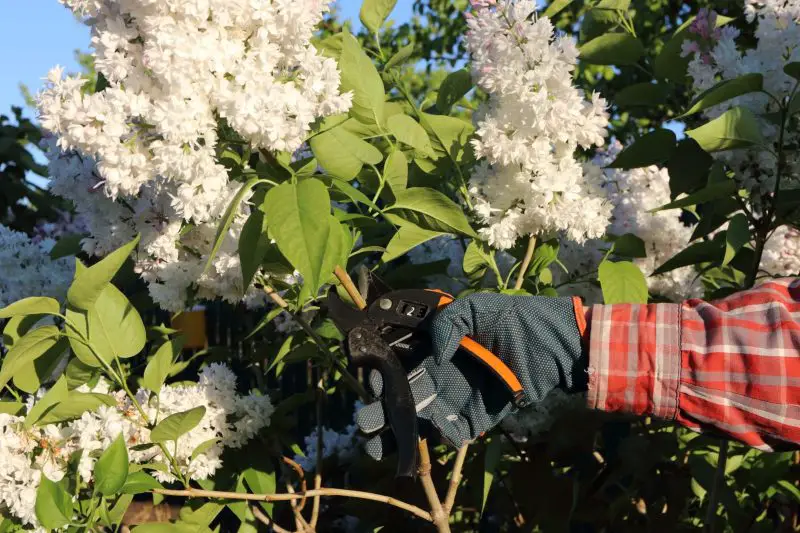Lilac bushes are beloved for their lush blooms and intoxicating fragrance that signal the arrival of spring. But without proper pruning at the right time, their beauty and vigor can quickly fade. Knowing when and how to cut back your lilac is key to keeping it healthy, full of flowers, and a joy to behold year after year.
In this guide, you’ll learn the best time to prune lilac bushes, how different varieties respond to trimming, and essential tips to avoid damaging next season’s blooms. Whether you’re a beginner gardener or looking to refine your technique, this article will help you unlock your lilac’s full blooming potential.
Understanding Lilac Growth and Blooming Cycles

Lilacs follow a predictable yearly cycle that directly influences when and how they should be pruned. In early spring, the plant awakens from dormancy and pushes out new shoots and buds. By mid to late spring, these buds open into fragrant blooms, which typically last for two to four weeks depending on the weather and variety.
Shortly after blooming ends, lilacs begin forming flower buds for the next year—a process that continues through summer. During this time, the plant channels energy into developing strong stems and preparing for dormancy. By fall, lilacs slow down growth, and in winter, they enter a rest phase to survive cold conditions.
Understanding this cycle is key for effective pruning. Since buds for next year’s flowers start forming soon after the current season’s blooms fade, any pruning done too late can remove these developing buds. Cutting back at the right moment—just after flowering—ensures healthy growth, better air circulation, and a fuller, more fragrant bloom the following spring.
The Best Time of Year to Cut Back Lilacs
The ideal time to cut back a lilac bush is immediately after it finishes blooming in late spring, typically from mid-May to early June, depending on your local climate. This window is crucial because lilacs set their flower buds for the following season soon after blooming. If you prune too late in the summer or fall, you risk cutting off next year’s flower buds and reducing the plant’s ability to bloom the following spring.
Pruning right after flowering not only preserves future blossoms but also stimulates fresh growth, encourages better air circulation, and keeps the shrub looking tidy and vigorous. This is especially important for mature or older lilac bushes that may have become woody or overgrown over time. Removing a few of the oldest, thickest canes each year right after bloom encourages younger shoots to emerge from the base, which tend to be more productive and flower more heavily.
In colder regions, such as USDA zones 3 through 5, it’s best not to wait too long after flowering to prune. Lilacs begin preparing for dormancy as summer ends, and any cuts made too late in the season may not heal properly before winter. Timely pruning also allows any new shoots that develop to harden off before the first frost. For gardeners in warmer areas, while the bloom time may shift slightly earlier, the rule still applies: prune as soon as flowering ends to support the plant’s health and ensure a vibrant display the following spring.
Why Timing Matters for Flowering and Fragrance
The timing of pruning a lilac bush is essential because it directly influences the plant’s ability to produce flowers and release its signature fragrance. Lilacs bloom on old wood, meaning they develop next year’s flower buds shortly after the current season’s blooms fade—usually by early to mid-summer. If you prune too late, such as in late summer or fall, you risk cutting off these developing buds, which results in little to no flowering the following spring.
This not only impacts the aesthetic value of the shrub but also its famous springtime scent, which depends entirely on a healthy and abundant bloom set. The sweet fragrance lilacs are known for is strongest when the plant is full of fresh blossoms. Pruning at the correct time—typically right after flowering—preserves these buds and directs the plant’s energy toward strong new growth and next year’s flower production.
Moreover, timely pruning helps maintain a balanced shape and opens up the center of the plant for better airflow and sunlight penetration. This improves overall plant health and may enhance both the strength and longevity of the blooms. In short, knowing when to cut back your lilac is one of the most important steps to ensure a fragrant, flower-filled spring display.
How to Identify Branches That Need Pruning
Knowing which branches to prune is essential for shaping your lilac bush, encouraging healthy growth, and maximizing flower production. Start by looking for branches that are clearly old, woody, and unproductive. These older stems are often thick, grayish, and may have fewer leaves or flowers than younger shoots. Removing a few of the oldest canes each year—typically those thicker than an inch—helps rejuvenate the shrub and encourages new, flower-producing growth.
Next, identify any crossing or rubbing branches. When branches grow inward or tangle with one another, they can damage bark and restrict air circulation, making the plant more susceptible to pests and diseases. These should be cut back cleanly to open up the center of the bush and allow better airflow and light penetration.
Also look for weak or spindly shoots that are not likely to support strong flowering. These smaller branches may drain the plant’s energy without contributing much to its beauty or health. Removing them redirects resources to stronger, more vigorous stems.
Finally, prune any diseased, dead, or damaged wood. Dead branches are brittle and break easily, while diseased ones might have discolored bark or unusual growths. Use sharp, clean pruning shears to cut these back to healthy wood or all the way to the base if needed.
By carefully evaluating and removing the right branches, you not only keep your lilac looking its best, but also improve its long-term vitality and seasonal performance.
Tools You’ll Need for the Job
Having the right tools makes pruning lilacs easier, safer, and more effective. The most essential tool is a pair of sharp bypass pruners, perfect for cleanly cutting small to medium-sized branches up to ¾ inch thick without crushing the stems. For thicker canes or older wood, loppers provide the extra leverage needed to make smooth cuts with minimal effort.
If your lilac bush is tall or overgrown, a pruning saw comes in handy for cutting large, woody stems at the base. Choose one with a curved blade for better control in tight spaces. For hard-to-reach areas, a pole pruner allows you to trim higher branches without a ladder.
Always carry a pair of gardening gloves to protect your hands from scratches and to maintain a firm grip on your tools. Finally, disinfectant spray or alcohol wipes are essential for cleaning blades between cuts, especially when removing diseased wood, to prevent spreading infections.
Using the right tools helps you make clean, accurate cuts that promote healthy regrowth and reduce plant stress.
Light Pruning vs. Rejuvenation Pruning
Understanding the difference between light pruning and rejuvenation pruning is key to maintaining a healthy, blooming lilac bush year after year.
Light pruning is done annually and focuses on shaping the shrub, removing spent blooms, and thinning out a few older stems to encourage air circulation and new growth. This type of pruning is gentle and typically done right after the lilac has finished blooming in late spring. It helps maintain the bush’s size and form while enhancing flower production for the following year. Light pruning also involves removing any crossing, damaged, or weak branches to keep the plant vigorous and tidy.
Rejuvenation pruning, on the other hand, is a more aggressive approach used on older or neglected lilacs that have become overgrown and produce fewer flowers. This method involves cutting one-third of the oldest, thickest stems all the way down to the ground each year for three consecutive years. By the end of this cycle, the entire bush will have been replaced with younger, more productive growth. This approach drastically improves both the structure and flowering capability of mature lilacs, though it may reduce blooming in the short term while the plant rebuilds its framework.
Choosing the right method depends on your lilac’s condition. Healthy, regularly maintained shrubs benefit most from light pruning, while overgrown lilacs often need rejuvenation pruning to restore their full blooming potential.
Pruning Lilacs by Age of the Plant
The age of your lilac bush plays a significant role in determining the best pruning approach to keep it healthy and blooming beautifully.
Young Lilacs (1–3 years old):
For newly planted or young lilacs, minimal pruning is needed. Focus on removing only damaged or weak shoots to help the plant establish a strong structure. Avoid heavy pruning during the first few years, as the shrub needs time to develop a robust framework and root system. Light shaping after the first bloom can encourage bushier growth and better form.
Mature Lilacs (4–10 years old):
Once your lilac is established, regular annual pruning becomes important. Prune right after flowering to remove spent blooms and thin out older stems. This helps maintain size, encourages airflow, and promotes vigorous new growth. Light pruning each year supports consistent blooming and prevents the shrub from becoming too dense or woody.
Old or Overgrown Lilacs (10+ years):
Older lilacs may become overgrown, woody, and produce fewer flowers. For these, rejuvenation pruning is often necessary. Gradually remove one-third of the oldest, thickest stems down to the ground each year for up to three years. This encourages fresh, vigorous shoots to replace aging wood. Be patient—blooming may decrease temporarily during this renewal process but will improve in the long term.
By tailoring your pruning based on the plant’s age, you support healthy growth stages and ensure your lilac remains a vibrant, fragrant feature in your garden for years to come.
Dealing with Old and Neglected Lilac Bushes
Reviving an old or neglected lilac bush can seem daunting, but it’s entirely possible with the right approach. The key lies in rejuvenation pruning, a method that focuses on cutting back one-third of the oldest and thickest stems down to ground level each year for three consecutive years. This gradual technique prevents shock and encourages the plant to direct energy toward new, vigorous shoots.
During the first year, focus on identifying stems that are woody, brittle, or no longer flower. Removing these will allow more light and air to penetrate the shrub, boosting overall health. In the second year, continue the process, but begin shaping the plant as well. By year three, most of the old wood should be gone, replaced by younger, productive stems.
Fertilizing with compost after pruning and keeping the plant well-watered through the recovery period can speed up rejuvenation. With patience and care, even lilacs that haven’t been pruned in decades can bloom profusely again.
Cutting Back Lilac Bushes in Small Gardens
Space limitations in urban or compact gardens can pose unique challenges for growing lilacs, which are naturally large shrubs. However, with proper pruning strategies, even small-space gardeners can enjoy their fragrance and charm. The key is maintaining a compact form while promoting healthy growth and blooms.
Start by choosing dwarf or compact lilac varieties, which naturally stay smaller. For standard varieties, yearly shaping after blooming becomes essential. Remove suckers at the base and trim back overly long branches to maintain a tidy silhouette. Avoid heavy pruning all at once, as this can shock the plant and reduce blooming.
You can also consider thinning out branches to create a more open structure without reducing the height drastically. This enhances air circulation, reduces disease risk, and helps the plant fit well within your space. Regular maintenance ensures your lilac bush remains both beautiful and manageable, even in limited square footage.
How Climate and Hardiness Zones Affect Cutting Back
The timing and severity of lilac pruning should always take local climate and hardiness zones into account. In colder regions (zones 3–5), lilacs may need gentler pruning, and it’s important to finish cutting back early in the summer to allow time for new growth to harden before winter. Late pruning in these areas can lead to winter damage or fewer blooms next spring.
In milder climates (zones 6–8), lilacs may benefit from more aggressive pruning, especially in cases of overgrowth or legginess. Plants here often grow faster and recover more quickly from trimming. However, heat and humidity can make lilacs more susceptible to disease, so thinning for airflow is especially important.
Regardless of zone, avoid pruning in fall or winter. This can trigger unwanted growth that won’t survive cold weather. Understanding your hardiness zone and typical seasonal patterns helps you develop a pruning schedule that maximizes flower production and long-term plant health.
Post-Pruning Care Tips for Healthy Lilacs
After pruning, your lilac bush will need some attention to ensure it recovers quickly and continues to thrive. The first step is to water deeply and consistently, especially if you removed a significant number of stems. This helps the roots stay hydrated and encourages new shoot development.
Apply a layer of compost or well-rotted manure around the base of the plant. This not only enriches the soil but also supports strong regrowth. Avoid high-nitrogen fertilizers, as they may encourage leafy growth at the expense of blooms. Instead, choose a balanced or phosphorus-rich fertilizer in early spring to promote flowering.
Mulching with organic matter like shredded bark or straw helps regulate soil temperature and retain moisture. It also prevents weed competition while the plant is focusing its energy on regeneration.
Keep a close eye on your plant during the weeks following pruning. Look for signs of stress such as drooping leaves or discolored stems. In cases of heavy pruning, it’s normal for the plant to take a season or two to return to full bloom, so patience is key.
If you live in a cold climate, avoid fertilizing late in the season. Tender new growth needs time to harden off before frost arrives. In warmer climates, continue watering during dry spells to prevent drought stress while the plant rebuilds its framework.
Pruning Advice for Specific Lilac Varieties
Common Lilac (Syringa vulgaris)
This classic lilac is known for its tall, upright structure and large, fragrant spring blooms. For Syringa vulgaris, prune immediately after blooming ends—typically late spring to early summer. Focus on removing spent flower heads and thinning out one-third of the oldest stems at the base every year to stimulate new growth. Avoid heavy pruning, as it can reduce blooms for the following year. Maintain an open center for better air circulation and light penetration.
Dwarf Lilac (Syringa meyeri ‘Palibin’, Syringa ‘Miss Kim’)
Dwarf lilacs bloom slightly later than common lilacs and are much more compact, making them ideal for smaller gardens. These varieties require far less pruning. Remove faded blooms to encourage a neat shape and prevent seed development. Light shaping and occasional removal of dead or crossing branches are usually enough. Avoid rejuvenation pruning unless the plant is overgrown, as dwarf lilacs are naturally slow-growing and can take time to recover.
Tree Lilac (Syringa reticulata)
Unlike shrub lilacs, Syringa reticulata grows as a small tree and blooms in early summer. Tree lilacs require little pruning. Focus on removing any suckers or water sprouts from the base and interior of the tree to maintain a strong central leader. Prune sparingly to preserve the tree’s natural form and to avoid interrupting its bloom cycle. Deadwood and weak branches can be removed in late winter or early spring, but major shaping should occur just after blooming.
French Hybrids
These cultivated hybrids are prized for their showy blooms and varied colors. French lilacs are vigorous growers, so they benefit from regular thinning. Prune spent flowers right after blooming and remove older, woody stems at ground level to renew the plant and boost flower production. Since these varieties can grow dense, periodic rejuvenation every 3–5 years helps maintain shape and blooming potential.
Reblooming Lilacs (Syringa ‘Bloomerang’ and others)
Reblooming lilacs flower in spring and again in late summer or fall. For these, deadhead the first flush of blooms immediately after fading to encourage the second round. Avoid heavy pruning that might interfere with the second bloom cycle. Shaping cuts should be done just after the spring flowering, while summer trimming should be limited to removing faded flowers only.
FAQs About Pruning Lilac Bushes
When is the best time to prune lilac bushes?
The ideal time to prune most lilac bushes is right after they finish blooming in late spring. Pruning during this window gives the plant time to set buds for the following year’s flowers. If you prune too late in summer or fall, you risk removing next season’s flower buds, which form shortly after the bloom cycle ends. For reblooming varieties, prune lightly after the spring bloom and deadhead again after the summer flush.
How much should I prune a lilac that has become overgrown?
For severely overgrown lilacs, a rejuvenation pruning approach is best. Remove one-third of the oldest, thickest stems at ground level each year for three consecutive years. This method gradually revitalizes the plant without sacrificing all blooms at once. Avoid cutting all stems down in a single season unless absolutely necessary, as this can shock the plant and delay flowering for several years.
Can I shape lilac bushes into a hedge or formal shape?
While lilacs can be lightly shaped, they naturally grow with a loose, upright habit. Formal hedging or topiary-like pruning is not recommended, as it can interfere with flowering and compromise the plant’s health. Instead, prune for structure by removing crossing branches, maintaining an open interior, and lightly shaping the outer canopy right after blooming.
What tools are best for pruning lilacs?
Use sharp, clean bypass pruners for small stems and hand loppers for thicker branches. A pruning saw may be needed for large, old stems near the base. Always sanitize your tools before and after pruning to prevent disease spread. Make clean cuts just above a leaf node or bud, and avoid tearing the bark or leaving ragged edges.
Should I deadhead lilac flowers after blooming?
Deadheading lilacs is optional but beneficial. Removing spent flower clusters right after blooming can improve the shrub’s appearance and redirect energy into root and shoot growth rather than seed production. While it won’t necessarily increase next year’s bloom count, it helps maintain a tidy and healthy plant. For reblooming types, deadheading is essential to encourage a second flush of flowers later in the season.
Conclusion
Pruning your lilac bush at the right time is essential for keeping it healthy, full of fragrant blooms, and beautifully shaped. With proper timing and method, you can avoid cutting off next year’s flower buds while also encouraging stronger growth and better air circulation. Whether you’re working with a traditional once-blooming variety or a modern reblooming type, consistent care through pruning ensures your lilac remains a garden highlight for many seasons. With each careful cut, you’re shaping not just the plant, but the future beauty of your outdoor space.






